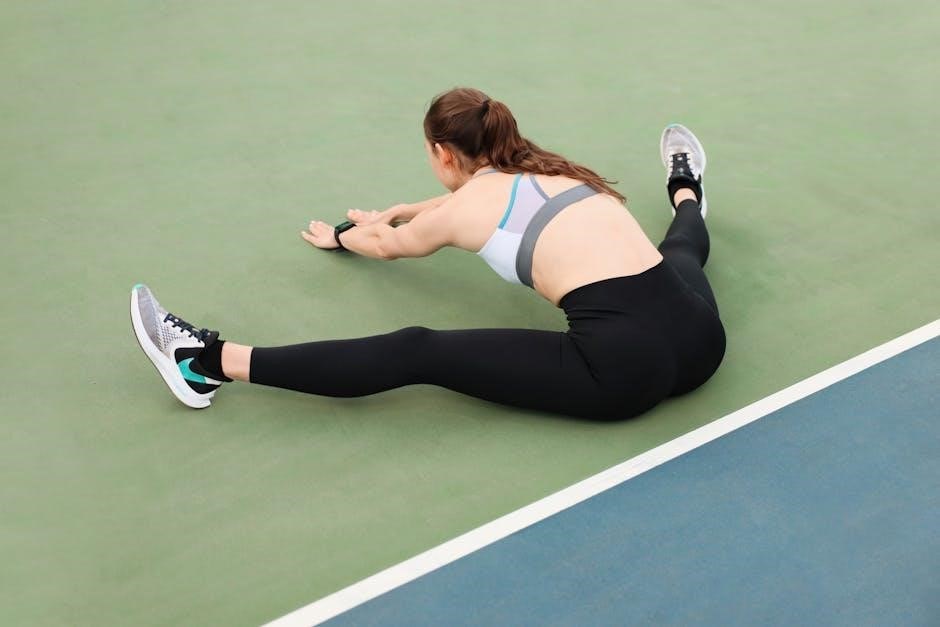Exercises for torn rotator cuff are essential for recovery, using
- low impact activities
and elastic materials to strengthen muscles and improve range of motion, as seen in torn rotator cuff exercises pdf files available online always.
Understanding the Importance of Exercise for Torn Rotator Cuff
Exercise plays a crucial role in the recovery of a torn rotator cuff, as it helps to improve range of motion, reduce pain and inflammation, and strengthen the surrounding muscles. According to various studies and torn rotator cuff exercises pdf files, a well-structured exercise program can significantly improve outcomes and reduce the risk of further injury. The importance of exercise for torn rotator cuff cannot be overstated, as it helps to promote healing, improve function, and enhance overall quality of life. By incorporating exercises into their daily routine, individuals with a torn rotator cuff can expect to see significant improvements in their symptoms and function over time. A
- comprehensive exercise program
typically includes a combination of stretching, strengthening, and range of motion exercises, all of which are designed to target the specific needs of the individual. Regular exercise can also help to prevent further injury and reduce the risk of chronic pain and disability.

Torn Rotator Cuff Symptoms and Diagnosis
Symptoms include pain and limited
- mobility
in the shoulder joint, often requiring medical evaluation and diagnosis through imaging tests and physical examination always online.
Common Symptoms and Causes of Torn Rotator Cuff
Common symptoms of a torn rotator cuff include pain and weakness in the shoulder, limited mobility, and difficulty performing everyday activities. The causes of a torn rotator cuff can be attributed to various factors, including traumatic injuries, chronic overuse, and degenerative conditions. According to torn rotator cuff exercises pdf, the rotator cuff muscles and tendons can become damaged due to repetitive strain or sudden trauma, leading to inflammation and tearing. The symptoms can be exacerbated by certain activities, such as lifting, throwing, or overhead movements. It is essential to seek medical attention if symptoms persist or worsen over time. A proper diagnosis and treatment plan can help alleviate symptoms and promote recovery. Additionally, lifestyle modifications, such as avoiding heavy lifting and taking regular breaks, can help prevent further injury and reduce the risk of developing a torn rotator cuff. Regular exercise and stretching can also help maintain shoulder health and prevent injuries.

Getting Started with Torn Rotator Cuff Exercises
Begin with
- low impact warm-ups
and gentle stretching to prepare muscles for exercises, as outlined in torn rotator cuff exercises pdf for optimal recovery and healing always online;
Warm-up and Stretching Exercises for Torn Rotator Cuff
Warm-up and stretching exercises are crucial for torn rotator cuff recovery, as they help increase blood flow and reduce stiffness in the affected area. According to torn rotator cuff exercises pdf, a 5-10 minute warm-up session using low-impact activities such as walking or riding a stationary bicycle is recommended. This is followed by gentle stretching exercises to loosen up the muscles and tendons, improving flexibility and range of motion. The exercises should be done slowly and carefully to avoid further injury. It is essential to listen to your body and stop if you experience any pain or discomfort. A physical therapist or doctor can provide guidance on the best warm-up and stretching exercises for your specific condition, as outlined in torn rotator cuff exercises pdf. Regular warm-up and stretching exercises can help promote healing and prevent further injury, allowing you to return to your normal activities.

Internal Rotator Strengthening Exercises
Using elastic materials like Thera-Band for internal rotator strengthening exercises helps improve shoulder stability and function, as shown in torn rotator cuff exercises pdf files available online always.
Protocol for Massive Rotator Cuff Tear Exercises
The protocol for massive rotator cuff tear exercises involves performing exercises 2-3 times a day, starting with pendulum warm-up exercises to improve range of motion and reduce stiffness.
Using a combination of low-impact activities and stretching exercises, individuals can improve their shoulder function and reduce pain.
The exercises should be done in a controlled manner, avoiding any movements that may cause further injury to the rotator cuff.
It is essential to follow a gradual progression of exercises, starting with simple movements and gradually increasing the intensity and difficulty.
This protocol can be found in various torn rotator cuff exercises pdf files available online, providing a comprehensive guide for individuals recovering from massive rotator cuff tears.
By following this protocol and consulting with a healthcare professional, individuals can improve their chances of a successful recovery and regain optimal shoulder function.
Regular exercise and physical therapy can help improve the overall health and function of the shoulder joint.

Frequency and Duration of Torn Rotator Cuff Exercises
Exercises should be done 2-3 times a week, with each session lasting 20-30 minutes, using
- low impact activities
to maintain strength and range of motion always online.
Importance of Consulting a Doctor or Physical Therapist
Consulting a doctor or physical therapist is crucial when dealing with a torn rotator cuff, as they can provide personalized guidance and help create a tailored exercise program.
Using information from torn rotator cuff exercises pdf files, a doctor or physical therapist can assess the severity of the injury and recommend the best course of treatment.
They can also help patients understand the importance of proper warm-up and stretching exercises, as well as provide guidance on how to perform internal rotator strengthening exercises correctly.
Additionally, a doctor or physical therapist can help patients monitor their progress and adjust their exercise program as needed.
By consulting a doctor or physical therapist, patients can ensure they are receiving the best possible care and minimize the risk of further injury.
Regular check-ins with a doctor or physical therapist can also help patients stay motivated and on track with their exercise program, leading to a faster and more successful recovery.
Overall, consulting a doctor or physical therapist is an essential step in recovering from a torn rotator cuff and achieving optimal results from exercise programs.
